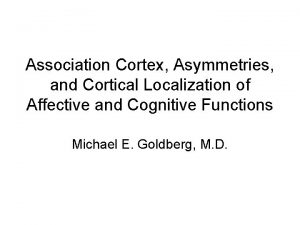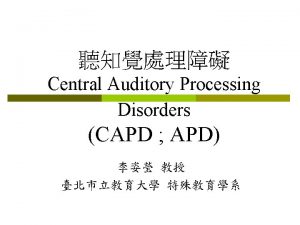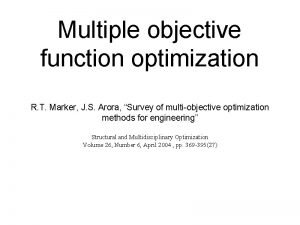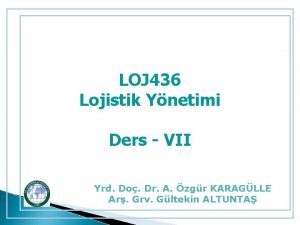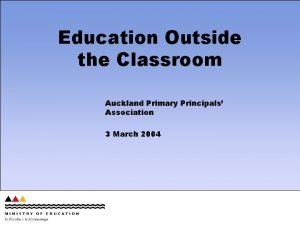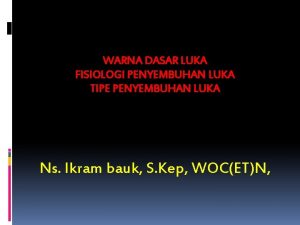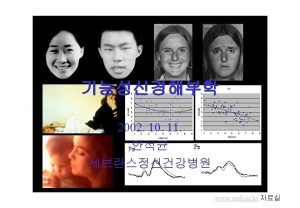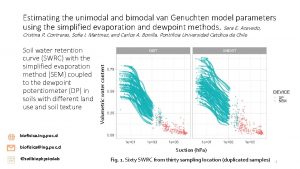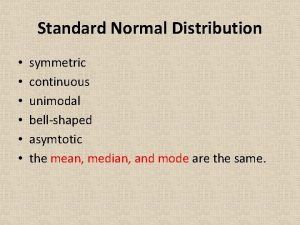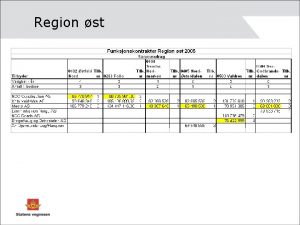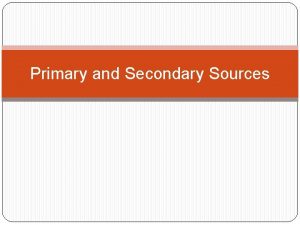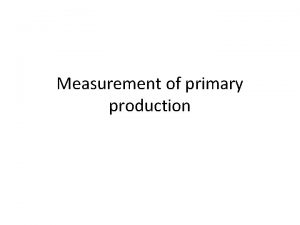Primary region Unimodal association region Heteromodal association region




































- Slides: 36



• Primary region • Unimodal association region • Heteromodal association region • Limbic region

Brodmann’s area

전두엽 장애 BA Sector 44, 45, 47 Frontal n Broca’s operculum aphasia n TCMA 6, 44 Precentral 8, 9, 10, 46 Dorsolater n Impaired verbal al intellect n Alexia n Impaired nonverbal intellect n 10, 11 Ventrome dial n Acquired sociopathy n Enviornmental dependency n. Acquired Mild akinetic mutism n 6, 8 Left Right Aprosodia n Restricted affect n TCMA n Alexia n Agraphia n Acquired sociopathy n Enviornmental dependency n Emotional disruption n Dorsomed n. Mild akinetic ial mutism Bilateral n n Apraxia Severely Impaired intellect sociopathy n Enviornmenta l dependency Akinetic mutism

두정엽 장애 BA Sector Left Right 39, 40 Inferior parietal lobule n Conduction aphasia n Tactile agnosia n Ideomotor apraxia n Alexia with agraphia n Gerstmann syndrome n 5, 7 Superior parietal lobule n Ideomotor apraxia n Bilateral Spatial neglect n Anosognosia n Tactile agnosia n Constructional apraxia Visuospatial defects Severe ideomotor apraxia n Gait apraxia n

후두엽 장애 BA Sector Left 18, 19 Supracal n Mild visuospatial carine defects extrastria n Slow reading te 18, 19 Infracalc arine extrastria te n Pure alexia n Achromatopsia n Right Bilateral n visuospatial defects n Mild Balint’s syndrome n Apperceptive visual agnosia n Achromatopsi a n Balint’s syndrome n Akinetopsia n Achromatopsia n Visual object agnosia n Prosopagnosia

측두엽 장애 BA Sector Left Right Bilateral 37 Posterolateral n TCSA n Alexia n Visuoperceptual impairment n Restricted affect n 20, 21 Inferolateral n Semantic impairment n 22 Superior n Wernicke’s aphasia n Pure word deafness n Amusia n 38 Polar n Impaired name retrieval for unique entities (esp persons) n Anomia n Impaired concept retrieval for persons Visual agnosia n Prosopagnosia Anomia n Semantic impairment Auditory agnosia Impaired retrieval of names and concepts for unique entities n

변연계 장애 BA Sector Left Right Bilateral 28 Mesial temporal n Verbal anterograde amnesia n Basal forebrain n Confabulatory amnesia n 24, 25 Anterior cingulate n Abulia n Attentional defects n 23, 26 Posterior cingulate Nonverbal n Complete anterograde amnesia Confabulatory amnesia Akinetic mutism Memory impairment n

인지영역 Left Aphasia, Alexia, Agraphia Acalculia Right-left disorientation Finger agnosia Ideomotor apraxia Verbal memory loss Right Neglect syndrome Visuospatial dysfunction - Visuoperceptual dysfunction - Geographical disorientation - Constructional apraxia Visual memory loss

Anterior half (frontal) Abulia, akinetic mutism Disinhibition Motor impersistence Executive dysfunction Posterior half (parietal, temporal, occipital) Visual agnosia - object (object visual agnosia) - face (prosopagnosia) - color (color agnosia) Balint syndrome

언어장애(Language disorder) 스스로 말하기 (Spontaneous speech) 알아듣기 (Auditory comprehension) 따라말하기 (Repetition) 이름대기 (Naming) 읽기 (Reading) 쓰기 (Writing)

Pathological symptoms related to language functions:

언어장애의 분류 Nonfluent aphasia Fluent aphasia Broca TM Global MT Wernicke TS Conduction Anomic NF NF F F Comprehension Good Poor Good Repetition Poor Good Naming Poor Poor Spontaneous speech


기억의 과정 (Stages of memory) 등록 (Registration) : sensory information 부호화 (Encoding) : processing of incoming information - ‘acquisition’ + ‘consolidation’ 저장 (Storage) : permanent record 접근 (Access) 인출 (Retrieval)




Papez Circuit and its Connections

Basal forebrain and memory n Binding together pieces of information of a particular event memory ‘set’ n Lesion in the basal forebrain alone has no memory deficit n Basal forebrain + frontal lobe + striatum memory deficit

Hippocampal formation n Transfer short-term memories to long-term memory: ‘consolidation’ n Strengthen the association between the new information and activation of previously stored information for 1 -2 years n Remote memories are stored in neocortex

Prefrontal lobe and memory n n n Monitoring and manipulation within working memory Strategies to facilitate memory-meta memory Organization of material before encoding Prospective memory Temporal organization of memory Suppression of task-irrelevant information

Prefrontal cortex function Selection of task-relevant information n Suppression of task-irrelevant information Golden gate bridge- color? n n n Location (parietal) n Color (temporal-occipital) n Shape (inferior temporal) Confabulation

Thalamus and memory Anterior nuclei and dorsomedial nuclei of thalamus n Korsakoff syndrome (antero and retrograde amnesia) n Decreased level of consciousness n Decreased attention and mental control n Executive dysfunction n

주의 (Attention) Def. : Orientation to and action upon selected sensory percepts and cognitive operations Arousal (level of wakefulness) : drowsiness, lethargy, stupor coma Vigilance (capacity to sustain attention and linked to arousal) : inattentiveness, distractibility Working memory (holding images and ideas “online” and manipulating them consciously; interface between attention and executive function) Clear sensorium and the continuity and coherence of working memory

Disorders of Global attention n Confusional state - rapid developing & transient - deficit of attention - reduced level of consciousness - abnormally increased or reduced psychomotor activity - disturbed sleep-wake cycle Delirium (hyperactive confusional state) Hypoactive confusional state n Confabulatory state n Subcortical Dysexecutive state

전두엽집행기능 (Frontal executive dysfunction Behavioral Lack of self-awareness Lack of appreciation of social roles and restrictions Flat affect, blunted emotional response, and decreased drive Imitation and utilization behavior Separation of action from knowledge

Cognitive Impaired “in real-life” intelligence Impaired executive function Inability to alter behavior in response to changing rules Inability to plan and handle multistep, sequential behaviors Inability to inhibit responses Perseveration Impaired working memory Impaired language Motor Primitive reflexes (grasp, groping, snout, palmomental)

Association cortex in the parietal, temporal, and occipital lobe Limbic cortex Premotor cortex Basal ganglia Thalamus Hypothalamus Midbrain Prefrontal cortex

Disorders of Higher Sensory Processing and Integration

TWO CORTICAL PATHWAYS FOR VISUAL PERCEPTION Dorsal visual pathway Spatial perception Visual neglect Optic ataxia Simultanagnosia Ocular apraxia Akinetopsia Ventral visual pathway Achromatopsia Visual object agnosia Pure alexia Prosopagnosia Color anomia Object perception and recognition

u Disorders of Reading Pure alexia (left infracalcarine occipital lobe) Alexia with agraphia (left inferior parietal lobule) Third alexia (left middle frontal gyrus) u Disorders of sensory integration Visuospatial Disorders Spatial neglect Impaired visuoconstruction Topographic disorientation Right-left disorientation Body schema Disorders Finger agnosia Autotopagnosia

실행증(Apraxia) n Disorder of skilled movement in the absence of elementary motor, extrapyramidal, cerebellar disorders n Greatest difficulty in attempting to pantomime an action (e. g. sawing a piece of wood, using a phone); improves with imitation, and best when using actual object n Failure of integration of motor function with visual perception, somatic sensation, and/or motor intention, such that motor acts are improperly executed.


u True apraxias Ideomotor apraxias Limb apraxia Oral apraxia Conceptual apraxia Callosal apraxia Ocular apraxia u Other apraxias Constructional apraxia Dressing apraxia Gait apraxia
 Unimodal vs heteromodal association cortex
Unimodal vs heteromodal association cortex Heteromodal association cortex
Heteromodal association cortex Heteromodal association cortex
Heteromodal association cortex Heteromodal association cortex
Heteromodal association cortex Unimodal function
Unimodal function Finorm
Finorm Taşıma modları ve karşılaştırmaları
Taşıma modları ve karşılaştırmaları Skewed right
Skewed right The primary pigments are _____ the primary colors.
The primary pigments are _____ the primary colors. Dc primary care association
Dc primary care association Missouri primary care association
Missouri primary care association Kentucky primary care association
Kentucky primary care association Auckland primary principals association
Auckland primary principals association Muscles of scapula region
Muscles of scapula region Active region and saturation region
Active region and saturation region Primary and secondary effects of a tectonic hazard
Primary and secondary effects of a tectonic hazard Yan oi tong tin ka ping primary school
Yan oi tong tin ka ping primary school Secondary headline
Secondary headline Words their way upper level spelling inventory
Words their way upper level spelling inventory Woodford green primary school
Woodford green primary school Theme for invictus
Theme for invictus Impact of business decisions on stakeholders
Impact of business decisions on stakeholders Meed wced
Meed wced Knowledge harvest ipc
Knowledge harvest ipc Meare village primary school
Meare village primary school Goosehill primary school
Goosehill primary school Gongshang primary
Gongshang primary Manor foundation
Manor foundation He works in a primary school in narail
He works in a primary school in narail Elementary science class 5
Elementary science class 5 Farzana and jamil are from kustia
Farzana and jamil are from kustia Primary pollutants and secondary pollutants
Primary pollutants and secondary pollutants Where can we find rotating arm sprays in sewage treatment
Where can we find rotating arm sprays in sewage treatment Tipe penyembuhan luka
Tipe penyembuhan luka Quinary industry
Quinary industry Primary sucession
Primary sucession Bree chisholm
Bree chisholm


